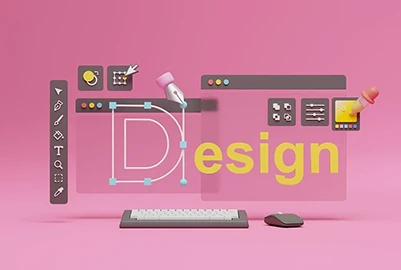Interested in learning about white space in design? Understand its significance and explore its types, best practices, and inspiring examples.
Have you ever noticed that the brand visuals and banner ads you’re drawn to or the designs that keep you interested in spending more time on a website or app have one thing in common? The intentional use of white space — a space not filled with design elements. This covers everything from small spaces between text and images to the large empty areas on a webpage.
White space is one of the most underrated aspects of graphic design. It allows users to scan a design effortlessly and makes it more readable and functional. The correct use of white space can significantly contribute to an attractive and successful design. In this comprehensive guide, we will discuss the importance of white space in graphic design, explain how to use it in your designs, and provide some inspirational examples.
Here’s everything we’ll cover in this article!
- What is white space in design?
- Types of white spaces in graphic design
- What is the importance of white space in graphic design?
- Difference between white space and negative space
- How to apply white space in design?
- Examples of white space in graphic design
- Final thoughts
What is white space in design?
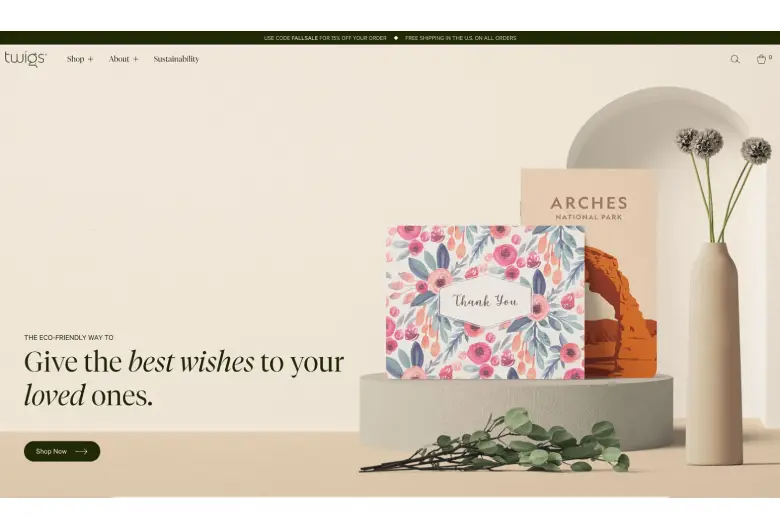
Image Courtesy: Flux Academy
White space is an empty space surrounding content and other design elements in a composition. It breaks the visual clutter and creates a sense of balance between words and images, making sure users remain engaged. Despite its name, it does not necessarily mean it needs to be white. This seemingly empty space can be of any color, texture, or pattern as long as it is devoid of shapes, text, or images. You can see white spaces on packaging labels, logos, websites, banners, and even on the pages of books.
The purpose of using white space in graphic design is to emphasize other design elements and allow them to breathe. However, occasionally, it is the white space that grabs the maximum attention. This can be intentional if the white space symbolizes a concept. White space also reduces the cognitive load on users as it guides their eyes, influences perception, and molds their experiences.
Types of white spaces in graphic design
Before understanding the nuances of applying white space in design, let’s take a look at its types. Here’s a breakdown of the different kinds of white spaces that you should be aware of:
1. Micro white space
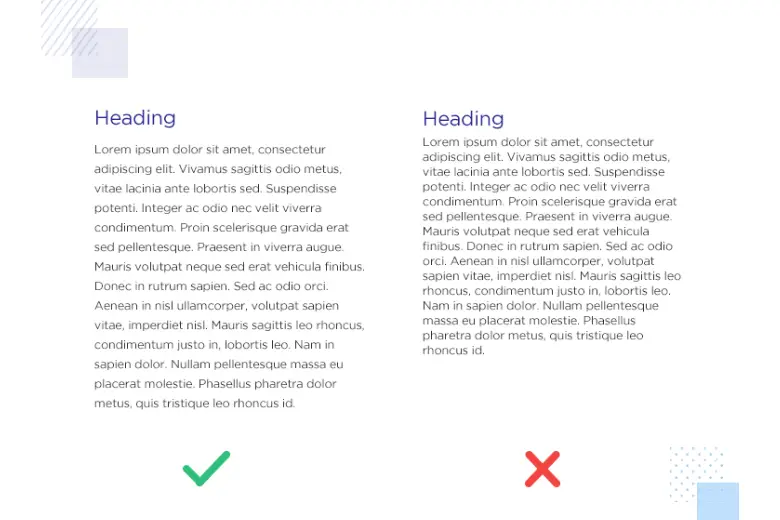
Image Courtesy: Justinmind
Micro white space refers to the minor gaps between letters, lines of text, paragraphs, icons, buttons, and images. It is typically used to ensure that text elements are legible and design elements are easily recognizable. While these spaces may be small, they can improve clarity and visual balance, making the composition feel less cramped. The purpose of micro white space is to guide the viewer’s eye across the design and create an effortless user experience. For example, when designing a photo gallery for a website, it is important to leave substantial space between the images to avoid confusion and clutter.
2. Macro white space

Image Courtesy: Creatopy
Macro white space is the larger area of empty space in a design layout. It creates a sense of structure and allows users to easily digest information. It is usually located to the right and left of most website content and between large chunks of content blocks. Unlike micro white space, macro white space is bigger and easily noticeable. For example, significant gaps between different sections of a webpage, like the space between a header, main content, and footer, help prevent the page from being too crowded.
3. Active white space
Active white space refers to the intentional use of empty space in a design to guide the flow of content, ensuring a smooth reading experience. It helps direct the reader’s attention to elements such as Call-to-Action (CTA) buttons while maintaining a clear layout. This strategic use of space keeps the reader engaged and makes it easier to navigate the content.
4. Passive white space
Passive white space occurs naturally when text and design elements are placed within a layout. It ensures that letters, images, and other components have enough separation to prevent overlap and maintain readability and visual clarity. Without this spacing, a website or campaign would appear disorganized and difficult to understand.
What is the importance of white space in graphic design?
White space is essential in any design and provides many advantages when used wisely. Here are a few compelling reasons why good designs need white space:
1. Improves legibility
White space helps break text into easily digestible chunks,making the content more readable and easier to understand. By surrounding text with substantial white space, you can prevent the reader from feeling overwhelmed with too much information at once, improving legibility. With that, you can also incorporate various colors, shapes, and other design elements to make the layout visually engaging and easier on the eyes.
2. Organizes and structures content
White space segregates as well as groups design elements to show how they are connected. By adjusting the space between elements, you can guide viewers to process information in a more organized and logical way. This mindful use of space makes it easier for the audience to understand and navigate the content.

3. Draws attention to essential elements
When we want to draw attention to something, we often make it larger or more prominent. The same principle applies to white space. The more white space you surround an element with, the more it stands out. In web design, incorporating ample white space, along with proper alignment, can help highlight important areas, like Call-to-Action (CTA) buttons, guiding users’ focus exactly where you want it.
4. Improves user interaction
In website design, white space creates a clear visual hierarchy, making it easier for users to find the information they need. By adding sufficient white space around elements like headers, buttons, and navigation menus, you can encourage users to take action. When used effectively, white space reduces distractions, helping users stay focused on their primary goal—consuming content—without unnecessary interruptions.
5. Maintains balance and visual order
Applying white space effectively creates balance and equally distributes design elements and empty space. This creates a visual hierarchy that makes the design more attractive and improves the user experience. Maximizing white space also helps achieve a clean and clutter-free look often associated with luxury, elevating the overall branding and design quality.
Difference between white space and negative space
The terms negative space and white space are often used interchangeably. However, they have subtle differences.
- Negative space is the area of the layout that remains untouched or empty. It may be around, between, or even inside the elements of all objects on the page or screen. On the other hand, white space refers to any empty space in a design, regardless of color, that is intentionally left blank to improve readability, structure, and focus. White space can be any color or pattern that contrasts with the design elements.
- While white space is about providing clarity, negative space is a design technique that uses empty areas creatively to form visual interest or convey a message.
- Both contribute to the overall aesthetic of a design, but negative space often plays a more artistic role in shaping the composition, and white space’s role is more functional.
How to apply white space in design
Now that we have a fair understanding of the importance of white space in design, let’s take a look at some tips and best practices for incorporating it into your work:
1. Develop a wireframe
Start by wireframing your website to plan the best use of white space. A wireframe allows you to refine your white space strategy by determining the right amount of spacing and padding for each element. It also provides a flexible way to experiment with different layouts before proceeding to more detailed design stages.
2. Focus on visual hierarchy

Image Courtesy: Venngage
White space isn't just for separating content and design elements—it is also used to arrange and position those elements strategically. By adding white space in the right place, you can guide the viewer's eyes to the essential areas of your design. One common approach is the Z-layout, often used in web design. This layout follows the natural scanning pattern of users: eyes start at the top-left, move to the top-right, then down to the center, and finally sweep from the bottom-left to the bottom-right. This flow helps prioritize and direct attention to important parts of the page.
3. Group content and elements logically

Image Courtesy: Justinmind
Logical grouping involves organizing information into meaningful categories. The Gestalt principle of proximity suggests that users perceive elements placed close together as related. To apply this effectively, group similar items near each other. For example, you should group related items together instead of putting product images in one area and listing the product names in a separate section. White space here helps separate these elements and content in a way that makes it easy to navigate.
4. Maintain proper text formatting
Proper margin use and sufficient paragraph and line spacing are effective ways to enhance text presentation with white space. In addition to using paragraphs to group related ideas, increasing the letter spacing can highlight headlines and titles. For optimal readability, the ideal line spacing should be between 130%-150% of the font size.
5. Keep the design minimal and clutter-free
A cluttered design can lead to cognitive overload, where information overwhelms the viewer’s memory, causing them to lose interest. To maintain clarity and cohesiveness, keep design elements simple and avoid unnecessary clutter. Ensure there’s enough white space around the text to balance out content-heavy areas, and use repetition to strengthen the visual hierarchy.
6. Remember that white space doesn’t have to be white

Image Courtesy: Justinmind
White space doesn't have to be just white or empty. It can be any color, pattern, texture, or even a background image as long as it helps highlight important elements and content in your design. Incorporating a well-chosen image as white space can create contrast and make various design elements pop.
Examples of white space in graphic design
Here are a few compelling examples for inspiration that can help you in your upcoming projects.
1. Apple

Image Courtesy: Mac Rumors
Apple was among the first to use white space effectively on the web, setting the standard for integrating breathing room into design. Their website cleverly balances active and passive whitespace. Strategically placed imagery directs the user’s eye down the page, while passive whitespace ensures a seamless browsing experience. Apple’s confident use of whitespace enhances attention, drives sales, and maximizes impact. With their products designed so efficiently, the website’s clean layout ensures visitors focus on one element at a time—free from distractions.
2. Squarespace
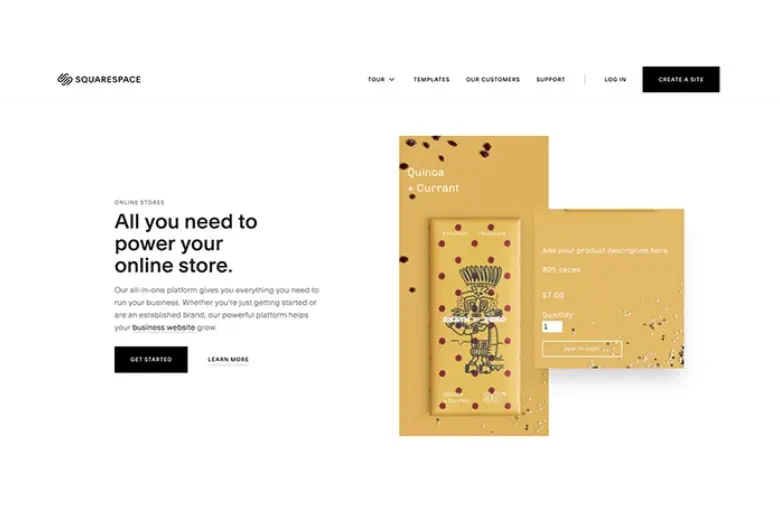
Image Courtesy: Impact Plus
Squarespace’s homepage features a minimalistic design with only a few UI elements, yet it effectively conveys its purpose. The strategic use of macro white space guides the user’s attention, starting from the top-left corner, then leading their gaze down to a polished webpage example, and finally across to the contextual text on the right. The white "Get Started" CTA button is prominently placed in the navigation bar, standing out against the black background, making it easy for users to take action.
3. Fraemohs Homes
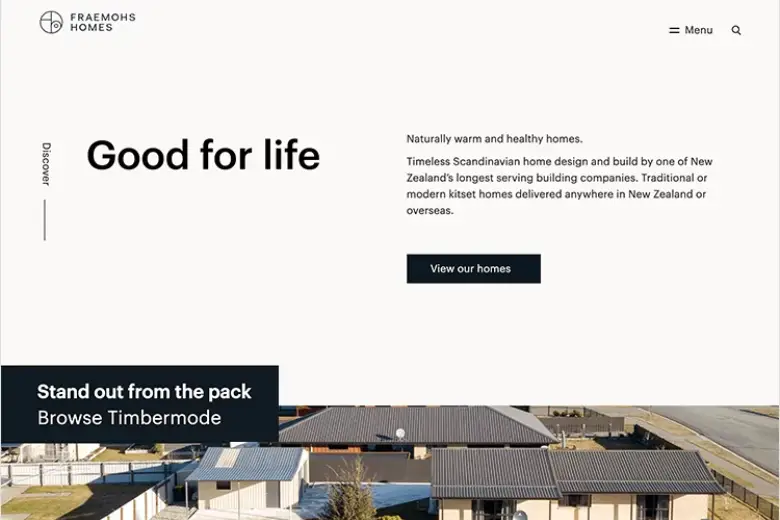
Image Courtesy: Justinmind
Fraemohs Homes offers stylish, Scandinavian-designed kit set houses that customers can order online and assemble themselves—similar to flat-packed furniture from IKEA. The website mirrors this modern construction approach with a clean and contemporary design. The strategic use of white space immediately draws users to their mission statement, followed by a bold black CTA button inviting them to explore available homes. The layout further enhances user engagement by guiding the eye in a Z-pattern through a mix of images and text, creating a seamless sense of discovery.
4. Quip

Image Courtesy: Justinmind
Oral healthcare brand Quip prioritizes user-centric design in both its products and website. The site features crisp imagery against a minimalist background, with ample passive white space around menu options for a clean and uncluttered look. It effectively applies the Gestalt principle of proximity by grouping related elements, such as menu items and customer reviews, for intuitive navigation. To highlight their products, Quip centers images and text while maintaining generous lateral margins, ensuring readability. The content layout follows an engaging Z-pattern, guiding users smoothly through the page.
5. Seedlip

Image Courtesy: Justinmind
Seedlip, a distillery specializing in non-alcoholic drinks, uses whitespace effectively to communicate its unique selling point with just a single line of copy. Embracing a “less is more” approach, the design highlights stunning photography, allowing users to explore the brand’s non-alcoholic spirits as they scroll. To reinforce a sense of quality and sophistication, the homepage initially presents only the elegant baroque-style logo, paired with intentional whitespace, emphasizing Seedlip’s luxurious identity.
6. Wealthsimple

Image Courtesy: Awards
Wealthsimple is a wealth management company that simplifies investing for those without a financial background. It combines technology with human support and provides an effortless experience. Their website design reflects this simplicity, using ample whitespace for clarity. The content follows an F-pattern, with text on the left and a bold “Start Investing” CTA that stands out against the white background. Dynamic imagery is strategically placed on the right—visually engaging yet not distracting.
Final thoughts
We hope you’ve found our comprehensive guide to white space in design insightful and understood its relevance as a design topic. As we’ve seen, white space impacts a brand’s visual identity and largely contributes to creating a wholesome user experience. With the rise of minimalism in response to increasing information overload, white space as a design element has become more important than ever. Additionally, it is applicable across all kinds of media.
To learn more about white space in design, which is a significant part of graphic design, check out the Graphic Design Course offered by AND, which comes with a comprehensive curriculum covering hands-on learning opportunities, unparalleled mentorship, and dedicated placement support. You can check out this project by AND Learner, Sanniddhi Goyal, to get an idea of all you can learn here!
If you’d like to know more about graphic design or related topics, head over to the AND Academy blog for more articles. As a starting point, you can consider going through the following resources:
12 Top Graphic Design Programs to Keep an Eye on in 2025
Graphic Designer Salary in India: Everything You Need to Know in 2025
12 Graphic Design Ideas and Trends To Light Up Your Next Project in 2025 (With Examples)
Next Steps
In case you need further assistance, here are some of our resources you can consider:
- Watch this session by design veteran and AND’s Academic Head, Prachi Mittal, and our Course Lead, Soumya Tiwari.
- Talk to a course advisor to discuss how you can transform your career with one of our courses.
- Pursue our Graphic Design courses - all courses are taught through live, interactive classes by industry experts, and some even offer a Job Guarantee.
- Take advantage of the scholarship and funding options that come with our courses to overcome any financial hurdle on the path of your career transformation.
Note: All information and/or data from external sources is believed to be accurate as of the date of publication.




